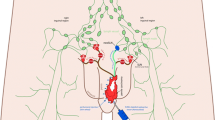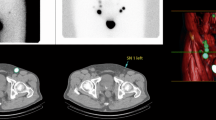Abstract
Purpose
The purpose of this study was to determine the potential role of the sentinel lymph node (SLN) procedure in limited lymph node dissection in patients with apparently localised prostate carcinoma.
Methods
In 27 patients with organ-confined prostate cancer, a single injection of 0.3 ml/30 MBq 99mTc-rhenium sulphur colloid was injected transrectally into the peripheral zone of each lobe of the prostate (total 0.6 ml/60 MBq) under ultrasound guidance. Two hours after injection, scintigraphy was performed. The first step in surgery was the detection and dissection of lymph nodes identified as SLNs. Then, standard lymphadenectomy was performed, consisting in a limited dissection that included all lymph nodes from the obturator fossa and along the external iliac vein. Lymphatic tissue along the hypogastric artery was not systematically removed, except in the presence of SLNs.
Results
Mean patient age was 66 years (48–77); the mean serum prostate-specific antigen value was 10.6 ng/ml. In a high proportion of patients (21/27, 77.8%) an SLN was located along the initial centimetres of the hypogastric artery. The second most frequent site of SLNs was in the obturator fossa (11/27 patients, 40.7%), followed by the external iliac area (5/27 patients, 18.5%). Four patients had lymph node metastases, all in SLNs: two in the hypogastric area and two in the obturator fossa.
Conclusion
The SLN procedure revealed the individual variability in the lymphatic drainage of the prostate. The main site of SLNs was the hypogastric area, and two of the four metastatic nodes were located at this site. A limited standard pelvic lymphadenectomy, excluding the hypogastric lymph nodes, would have missed half of the lymph node metastases in this study. A radionuclide SLN procedure could assist in the correct staging of patients with early prostate cancer, especially when performing limited lymphadenectomy.

Similar content being viewed by others
References
Clark T, Parekh DJ, Coockson MS, Chang SS, Smith ER, Wells N, et al. Randomized prospective evaluation of extended versus limited lymph node dissection in patients with clinically localized prostate cancer. J Urol 2003;169:145–8.
El-Galley RE, Keane TE, Petros JA, Sanders WH, Clarke HS, Cotsonis GA, et al. Evaluation of staging lymphadenectomy in prostate cancer. Urology 1998;52:663–7.
Bader P, Burkhard FC, Markwalder R, Studer UE. Is a limited lymph node dissection an adequate staging procedure for prostate cancer? J Urol 2002;168:514–8.
Burkhard FC, Bader P, Schneider E, Markwalder R, Studer UE. Reliability of preoperative values to determine the need for lymphadenectomy in patients with prostate cancer and meticulous lymph node dissection. Eur Urol 2002;42:84–92.
Heidenreich A, Varga Z, Von Knobloch R. Extended pelvic lymphadenectomy in patients undergoing radical prostatectomy: high incidence of lymph node metastasis. J Urol 2002;167:1681–6.
Campbell SC, Klein EA, Levin HS, Piedmonte MR. Open pelvic lymph node dissection for prostate cancer: a reassessment. Urology 1995;46:352–5.
Haese A, Epstein JI, Huland H, Partin AW. Validation of a biopsy-based pathologic algorithm for predicting lymph node metastases in patients with clinically localized prostate carcinoma. Cancer 2002;95:1016–21.
Pisansky TM, Zincke H, Suman VJ, Bostwick DG, Earle JD, Oesterling JE. Correlation of pretherapy prostate cancer characteristics with histologic findings from pelvic lymphadenectomy specimens. Int J Radiat Oncol Biol Phys 1996;34:33–9.
Ghavamian R, Blute ML, Bergstralh EJ, Slezak J, Zincke H. Comparison of clinical non palpable PSA detected (cT1c) versus palpable (cT2) prostate cancers in patients undergoing radical retropubic prostatectomy. Urology 1999;54:105–10.
Harisinghani MG, Barentsz J, Hahn P, Deserno WM, Tabatabaei S, Hulsbergen van de Kaa C, et al. Noninvasive detection of clinically occult lymph-node metastases in prostate cancer. N Engl J Med 2003;348:2491–9.
American Joint Committee on Cancer 2002. Cancer staging handbook: TNM classification of malignant tumors. 6th ed. Berlin Heidelberg New York: Springer; 2002.
Sobin LH, Fleming ID. TNM classification of malignant tumors. 5th ed. 1997. Union Internationale contre le Cancer and the American Joint Committee on Cancer. Cancer 1997;80:1803–4.
Brossner C, Ringhofer H, Hernady T, Kuber W, Madersbacher S, Pycha A. Lymphatic drainage of prostatic transition and peripheral zones visualised on a three dimensional workstation. Urology 2001;57:389–93.
Brossner C, Ringhofer H, Schatzl G, Maderbacher S, Powischer G, Kuber W. Sacral distribution of prostatic lymph nodes visualized on spiral computed tomography with three-dimensional reconstruction. BJU Int 2002;89:44–7.
Raghavaiah NV, Jordan WP. Prostatic lymphography. J Urol 1979;121:178–81.
Zuckier LS, Finkelstein M, Kreutzer ER, Stone PL, Freed SZ, Bard RH, et al. Technetium-99m antinomy sulphide colloid lymphoscintigraphy of the prostate by direct transrectal injection. Med Nucl Commun 1990;11:589–96.
Wawroschek F, Vogt H, Weckermann D, Wagner T, Hamm M, Harzmann R. Radioisotope guided pelvic lymph node dissection for prostate cancer. J Urol 2001;166(5):1715–9.
Wawroschek F, Wagner T, Hamm M, Weckermann D, Vogt H, Märkl B, et al. The influence of serial sections, immunohistochemistry, and extension of pelvic lymph node dissection on the lymph node status in clinically localized prostate cancer. Eur Urol 2003;43(2):132–6.
Wawroschek F, Vogt H, Wengenmair H, Weckermann D, Hamm M, Keil M, et al. Prostate lymphoscintigraphy and radio-guided surgery for sentinel lymph node identification in prostate cancer. Technique and results of the first 350 cases. Urol Intl 2003;70(4):303–10.
20. Takashima H, Egawa M, Imao T, Fukuda M, Yokoyama K, Namiki M. Validity of sentinel lymph node concept for patients with prostate cancer. J Urol 2004;171:2268–71.
Acknowledgements
The authors thank Maryna B. Gabert for revision of the English text.
Author information
Authors and Affiliations
Corresponding author
Rights and permissions
About this article
Cite this article
Brenot-Rossi, I., Bastide, C., Garcia, S. et al. Limited pelvic lymphadenectomy using the sentinel lymph node procedure in patients with localised prostate carcinoma: a pilot study. Eur J Nucl Med Mol Imaging 32, 635–640 (2005). https://doi.org/10.1007/s00259-004-1750-3
Received:
Accepted:
Published:
Issue Date:
DOI: https://doi.org/10.1007/s00259-004-1750-3




